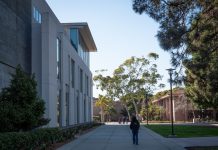Ariana Trelles-Duckett
Copy Editor & Contributing Writer
A lot can be learned from the devastating extent of the fires scorching the Los Angeles (L.A.) area in the past two weeks. As firefighters continue to battle many ongoing wildfires around L.A., the fires’ impacts have been felt by many. Buildings have been reduced to ashes, road signs have been melted, and smoke continues to fill the sky. But there’s more to the mass destruction than an ignited flame in poor weather conditions. The catalysts, results, and terminations of wildfires will be explored below.
The First Flame
A mix of strong winds and dry air can cause vegetation to spark in any season. California sees dry weather very often, but the driest season lasts from May to September. Climate change exacerbates the dryness through longer droughts, higher temperatures, and unpredictable precipitation. These make wildfires more likely to occur, especially during the peak of the fire season throughout the summer. The unusualness of a massive wildfire in January, which is typically part of California’s wet season, only further proves the continuous threat climate change poses to the state’s residents and wilderness.
An additional environmental cause is dry lightning. Dry thunderstorms produce little precipitation but plenty of lightning. This sparks brush and ignites flames in a short amount of time. In addition, hotter lightning burns vegetation more readily. Lightning strikes are also becoming more frequent from climate change. Higher temperatures cause more lightning to strike, creating a positive feedback loop that links the atmosphere’s temperature, lightning strikes, and wildfires.
Deforestation, which leaves dry vegetation exposed to the elements, can also pave the way for wildfires to expand fast. Trees play an important factor in mitigating wildfire risk because some types of wood take a long time to burn. This allows some trees, such as northern California’s trademark redwoods, to remain standing — charred but intact — in recently burned forests.
Humans are an additional cause of massive fires. The 2018 gender reveal party, which burned around 47,000 acres of land, demonstrates the importance of fire safety in social gatherings. Paying close attention to campfires, barbeque grills, and explosives help mitigate preventable fires.
The Devastation of L.A.
Thousands of homes, businesses, and schools have been destroyed, impacting many communities who had to evacuate. Although L.A. has dealt with wildfires in the past, factors such as high temperatures and low rainfall, and the strength and direction of the Santa Ana winds, caused the fires to spread far throughout areas like Pasadena and Altadena. The Palisades and Eaton fires, which are the largest of the ongoing fires, are not as large as some of California’s worst wildfires, but the extent of their destruction exceeds most wildfires throughout California’s history.
Several factors caused such a large portion of L.A. to be devastated by the fires. L.A. is a densely populated city, which allowed the flames to spread easily between close-together buildings. Proximity to vegetation, which catches fire easily, as well as building materials and design also played parts. Some fire-resistant houses could survive much better than others due to features such as tempered-glass windows (which shatter from heat more slowly) and stucco (which takes longer to burn than wood). Not all buildings in L.A. have these features, however, so they had little chance of surviving as the winds pushed fires through entire neighborhoods.
Plant & Animal Ecosystems
Many animals can sense fires in the making even before a substantial region of land is burning. If they are able to flee, loss of a home can cause their species to be unable to breed, decreasing the number of members in the species. If they are unable to flee, smoke inhalation and burns can occur, causing internal and external injury.
As animals shift habitats, they face unfamiliar predators as well as new threats, such as evacuated people and their pets. Even after the wildfires have ceased, bodies of water can be contaminated by the materials burned, such as plastic, making them unsafe for animals to drink from. Plants that may have been parts of animals’ diets need time to grow back into the habitat, impacting their food source as well.
The Ecological Benefits of Wildfires
It’s important to note that wildfires are natural occurrences — besides the exacerbation of climate change making them very frequent — and can replenish the environment of the affected area. That’s why controlled burns, a preventative measure that Indigenous people across the world have done for centuries and which scientists continue to do today, greatly help ecosystems thrive for several reasons. When dead organic material builds up on the Earth’s surface, it makes it more difficult for animals to access the ground’s nutrients. Burning limited portions of the land clears out these decaying plants and helps animals reach the soil more easily. In addition, excess dead organic material can cause wildfires, which controlled burns mitigate. Land which has just burned won’t burn again until new material has grown in. This can protect entire patches of wilderness from igniting in the near future, and reduce the vast size some wildfires can reach.
The soil itself benefits from the nutrients released from wildfires, revitalizing the land and new plant growth in the region. The reproduction of several species of insects are also linked to post-wildfire environments, such as fire chaser beetles, who lay their eggs in newly burnt wood.
As previously mentioned, plants have different responses to fire depending on their composition, such as wood burning more slowly than a flower bush. The inability of certain materials to conduct heat — which therefore reduces the chance of catching on fire — is known as thermal insulation, and it’s present in dead leaves and moist plant tissue in addition to tree bark.
Plants can benefit from wildfires, too. Some need fire for their seeds to sprout, such as the fruits of the lodgepole pine. Fire allows some plants to flower as well as trees’ buds to open, like several species of Eucalyptus.
When Wildfires Finally Finish Burning
Wildfires always eventually lose their fuel. Becoming surrounded by bodies of water or already charred land, or put out by enough fire retardant and water released by firefighters, prevents the devastation from spreading any further. However, it can take weeks for a wildfire to be fully extinguished even after it has been controlled.
As air pollution thins throughout the atmosphere, the land is permanently reshaped by what’s happened. Plants may grow back fast, and some trees may have never perished, but the vast majority of animals suffer setbacks in reproduction and face new threats during and after evacuation.
How to Help
There are many ways to support those affected by or involved in extinguishing the ongoing fires in L.A. First, it’s important to check websites’ specific requests first to learn how to best help. Impacted communities need long-term support to best rebuild their lives and homes, in which volunteering could go a long way. If not possible, donating essential items such as air filters, canned food, and toiletries or money to relief organizations also helps. NBC News has a list of trustworthy organizations which are taking donations and accepting volunteers.

















